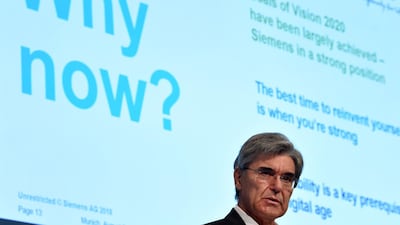Siemens announced its most sweeping overhaul in years as Europe’s largest engineering firm tries to adapt to new technologies that are disrupting its core businesses and avoid the fate of General Electric, its struggling rival.
The Munich-based company said it will shrink the number of operating divisions to three from five as it focuses on factory software and energy distribution. It pledged to boost revenue growth and the return on sales of Siemens’s industrial business by 2 percentage points in the medium-term even as its once-flagship gas turbine business deteriorated.
The target is a “massive promise to the markets and our shareholders”, said chief executive Joe Kaeser.
The new structure, along with third-quarter earnings, received a cool reception from investors, who sent shares down as much as 5 per cent, the most in just over two years. The company’s so-called industrial business profit missed estimates and showed a worsening outlook for the power division.
Net profit fall 14 per cent in the most recent quarter as higher taxes and lagging profits at its oil and gas business weighed on earnings.
On the positive side, the company said it booked sharply higher orders, a key factor for earnings down the road. Those included €800 million (Dh3.41bn) for a train control system in Norway and 1.3 billion euros for an offshore wind farm in Britain.
Net profit fell to €1.21bn from €1.41bn in the same quarter a year ago, the company's fiscal third.
The oil and gas business saw earnings fall by more than half to €164m as global energy trends reduced demand for the division's offerings including for gas turbines to generate electricity.
With the reorganisation, Mr Kaeser is aiming to leave a lasting imprint on the once-sprawling manufacturer and guard against GE’s downward spiral. The flagging US giant has embarked on a far-reaching restructuring plan after coming under pressure from an activist investor and getting kicked out of the Dow Jones Industrial Average.
Siemens shares fell 4.5 per cent to €114.38 at 11am in Frankfurt, leaving them 1.4 per cent lower over the past year compared with a 48 per cent drop for GE.
Thursday’s decline “is likely due to the further weakening in the power business”, said Berenberg analyst Simon Toennessen. The company is expecting low-to-mid single-digit margins after the overhaul in 2019 compared with a mid single-digit figure this year.
Siemens’s overhaul foreshadows investments in new fields like energy management and charging networks for electric vehicles. On Wednesday, it said it will pay €600 million (Dh2.56 billion) to buy Mendix, a coding platform for businesses developing mobile and web apps.
_______________
Read more:
Exclusive: Siemens in discussions to develop Pakistani power plants
Exclusive: German Siemens and French Alstom to complete rail merger this year
_______________
The new plan is a surprise that is both positive and ambitious, Morgan Stanley analyst Ben Uglow said in a note. By making the distinction between strategic companies, in which Siemens has a majority stake, and wholly-owned operating companies, Siemens may be signalling some of the former could be sold, he said.
Mr Kaeser skirted questions on whether the company plans to divest from the struggling turbine business that has suffered from a collapse in orders amid a global shift to renewable energy sources. The company is cutting around 6,900 jobs mostly at the division and is said to mull its sale.
When he took the top post at Siemens in 2013, the German firm had 18 divisions and a byzantine structure. Over the years, he has been remaking the company and its three new divisions covering power, city infrastructure and digitisation are set to be in place in 2019. In a swipe at GE last year, Mr Kaeser said “old-fashioned conglomerates no longer have a future.”
Yet, the range of its offerings could still leave room for refining. “The conglomerate structure is staying intact for now,” Sven Diermeier, an analyst at Independent Research, said by phone. “It’s not like GE, where they already said what divisions they are separating themselves from.”
Mr Kaeser has focused on whittling down Siemens by selling, merging or bringing businesses to the stock market. The last moves were an initial public offering of the healthcare division, and a planned merger of the mobility unit with French company Alstom. Driving the overhaul is an accelerating move by customers for automated factory equipment and software to run manufacturing.

